The only part of the induction cooktop that gets hot is the area under the pot or pan. The surface around the cookware remains relatively cool, so most liquids will not burn on the surface, except liquids that get caught between the hob and the bottom of the pot. This is why the induction hob is much easier to clean than a gas burner. The smooth glass top makes maintenance easier and the touch control buttons are also easier to clean compared to control buttons.
However, because the glass plate is susceptible to scratches, some precautions must be taken when you clean your induction hob. You should use no product that is rough and abrasive, as it can leave scratches on the surface.
1. Cleaning Before Putting the Appliance in Use
You must clean the cooktop surface thoroughly before you start cooking any food.
Before you use the appliance for the first time, clean the glass plate with an approved ceramic/glass cooktop cleaner. This helps to protect the glass surface making future cleanup easier.
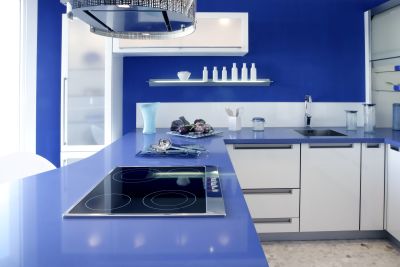
- Unplug the appliance and let it cool before cleaning.
- Apply a few drops of a non-abrasive cleaning liquid. Use only cleaners and tools specially designed for cleaning glass or ceramic surfaces. The owner’s manual usually includes a list of recommended cleaners for your induction hob.
- Use a damp sponge or cleaning pad to smooth the cleaner all over the cooktop surface.
- Use a dry microfiber cloth or paper towel to wipe up cleaning residue and polish the cooktop surface.
2. Regular Cleaning
Clean the cooktop surface regularly, preferably after each use. Switch off the cooktop before cleaning and wait until the surface is cool. Using a cleaner on a hot surface can create fumes that are hazardous to your health and may cause spotting.
- Apply a few drops of manufacturer-approved cleanser to the cooktop surface.
- Wipe the cooktop surface with a soft, moist cloth removing all cleaner residue. Left uncleaned, the cleaner residue will burn into the cooktop, causing the glass to become stained.
- Dry the surface completely and polish it with a clean, soft towel.
Recommended product: Cerama Bryte Ceramic Cooktop Cleaner
3. Removing Spills and Burned-on Residue
The spills and burnt-on stuff cannot be wiped off with dishwashing soap and water. To complete this task, you must use the appropriate cleaning tools.
Remove the pieces of food and loose dirt with a plastic scraper and a wet paper towel. Make sure the surface is cool before using a plastic scraper because the plastic would melt at high temperatures.
Use a soft cloth to apply a non-scratch cleaner to soak the spills and hardened residue. Use a scrubbing pad suitable for glass cooktops and scrub the area clean. Repeat until the residue is gone.
For the most stubborn residue, use a shielded scraper blade designed for cleaning burned-on deposits and hardened cooking spills without damaging the cooktop finish. Hold it at a 45-degree angle while scraping off the hardened residue. Carefully apply pressure to ensure the blade will not scratch the surface. Use the razor blade combined with an approved cooktop cleaner and a scrubby cleaning pad. Scrub the spills with the pad in a circular motion until they are gone. For best results, clean the spills and spatters before they become hardened and difficult to remove.
Dry sugar, food with high sugar content, and melted plastic may permanently damage the glass surface if left to cook. This kind of mess must be cleaned as soon as possible. It is best to remove sugary food spills while the surface is still hot using the razor blade scraper at an appropriate angle. Turn off the cooktop and wear an oven mitt to prevent burning yourself if the surface is still hot. Allow the appliance to cool down, then use the special induction hob cleaner and a cleaning pad the same way as for tough stains.
4. Cleaning Metal Marks and Scratches
Some cookware may leave metal markings on the cooktop surface. Lift your pans when you need to move them, instead of sliding cookware pieces across the glass. Uncoated cast iron pans are more likely to cause marks on the glass compared to stainless steel. Copper and aluminum cookware can leave marks that are very hard to get off.
Scratches on the glass cooktop can be unsightly but will not affect its cooking performance. Surface scratches can be caused by rough-edged cookware or by using abrasive cleaning products. Cleaning fluids must be completely smooth in texture. To minimize marks, always check the backside cookware surface for rough spots before using it the first time, and only use pans that have a flat and smooth bottom.
To remove water spots from the cooktop and add a glossy sheen, apply some white vinegar solution over the surface. Wipe the cooktop surface with a soft cloth, then buff dry with a clean cloth or paper towel.
Things to Avoid when Cleaning an Induction Stove Top
- To avoid damage to the cooktop finish, do not use rigid brushes, abrasive pads, or any abrasive cleansers. Use only the cleaners specially designed for cleaning glass or ceramic surfaces and use soft wiping materials.
- Avoid using cleaners that contain ammonia or chlorine bleach as they can permanently stain the cooktop.
- Don’t use caustic cleaning agents, flammable liquids, or any petroleum products for cleaning the cooktop.
- Do not use a knife or any sharp tools to scratch the hardened residue to avoid damage to the glass surface.
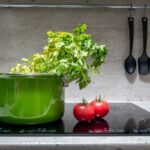
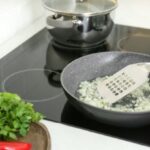
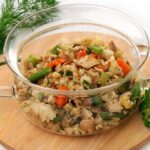
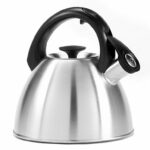
Great idea.thanks for sharing with us.But I am confused to cleaning.
Wow your article very informative. Thanks for sharing such a useful post.